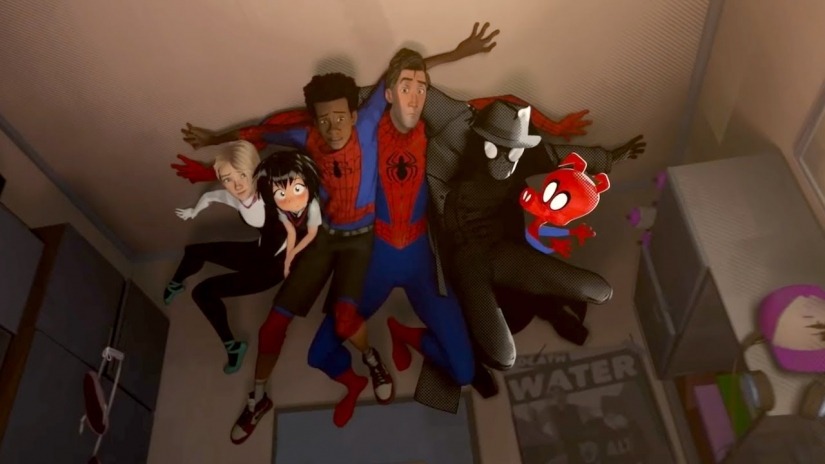REVIEW BY ALEXANDER MARGAVIO
This review contains minor spoilers regarding Spider-Man: Into the Spider-Verse plot details.
With Superhero films dominating the cinemas for more than a decade, it’s no surprise that eventually something new and drastic had to be made to go head-to-head against the Marvel Cinematic Universe in the superhero movie genre.
Enter Spider-Man: Into the Spider-Verse, produced By Sony Pictures Animation and Columbia Pictures in association with Marvel. Unlike all the previous Spider-Man films, Spider-Verse is entirely animated, and features a sizable cast of Spider-themed superheroes rather than focusing solely on one Spider-Man. And it’s one of the best Spider-Man films yet.
The story is entirely new for the film, while pulling elements from the comic line with the same name, Spider-Man: Spider-Verse. The overall story has been effectively reworked and trimmed to fit the film format and hits a lot of familiar themes that Spider-Man films have become known for, such as the importance of family, self-sacrifice, and growing up into a new identity. The mix of familiar themes with new characters and ideas create a narrative that’s sure to test the time like other beloved Spider-Man films.
Spider-Verse weaves the tale of young Miles Morales (voiced by Shameik Moore); a spunky and artistic teenager who’s starting a new life at prep school in New York. Miles adores the heroic outings of his world’s Spider-Man (Chris Pine), while his police officer father, Jefferson Davis (Brian Tyree Henry), naturally disapproves of the web-slinging vigilante superhero. While hanging out in a abandoned subway lot with his uncle, Aaron Davis (Mahershala Ali), Miles is suddenly bit by a radioactive spider, and begins experiencing the same spider-like powers as Peter Parker, whom he comes across and witnesses him fighting the Kingpin himself, Wilson Fisk (Liev Schreiber), who has created a devastating dimension-crossing machine that can pull people from the multiverse.
This is where the film begins to pick up action, showing Miles struggling with all this newfound power, visualizing his sensory overload with head-spinning colours and camera angles, while showcasing a very acrobatic and experienced Peter Parker fighting off the Green Goblin and Kingpin, with his scenes having much more cohesive visuals to show his years of experience as Spider-Man.
After seeing Peter Parker die at the hands of Kingpin, Miles knows that he must shut down Fisk’s machine, for it could destroy the entirety of New York if activated again, but feels lost without a mentor to guide him on how to properly use his newfound powers. Miles runs Spider-Man from another dimension, who goes by Peter B. Parker (Jake Johnson), a jaded, out of shape Spider-Man who spiralled into depression after divorcing his universe’s Mary Jane Watson, and losing his Aunt May. Peter B. Parker reluctantly agrees to mentor Miles into becoming the next Spider-Man, and promises to help him stop the Kingpin’s machine from tearing the multiverse apart.

The relationship between Miles and Peter is one of the character highlights of film. While it starts with Peter being an unenthusiastic and sarcastic mentor figure (even outright rejecting to teach Miles when they first meet), it slowly grows into almost a brotherly relationship as Peter sees Miles grow into his own Spider-Man, which reminds Peter of a time when he was just as optimistic and bright-eyed as Miles. Moore and Johnson bring a lot chemistry to Miles’ and Peter’s friendship through stellar voice performances that aren’t too over the top or understated.
After breaking into an advanced research centre and fighting this universe’s version of Doctor Octopus (Olivia Octavius voiced by Kathryn Hahn), the two Spider-Men run into Gwen Stacy, a Spider hero from another alternate dimension who also promises to help. The three heroes meet up with this world’s Aunt May Parker, whose still alive. She introduces Miles, Peter and Gwen to three other Spider-people who were also pulled from their worlds. These include Spider-Man Noir (A hard-boiled detective Peter Parker from a 1930’s universe, voiced by Nicolas Cage), Spider-Ham (a cartoon pig from a Looney Tunes-type dimension, voiced by comedian John Mulaney), and Peni Parker (A Japanese-American girl from an anime-type dimension with a mech robot companion piloted by a radioactive spider, voiced by Kimiko Glenn). All five other-worldly Spider-People decide to work together to stop Kingpin, and teach Miles what it truly means to be Spider-Man.
The fight scenes become visual spectacles once all six Spider-Heroes are brought together, with quick and eye-catching choreography as the camera quickly moves from hero-to-hero, showcasing each of their unique fighting styles and how they work in tandem with each other. These qualities create a superhero-sized, eye-popping experience that couldn’t be done as effectively if attempted in the Marvel Cinematic films.

All the voice actors in this film put their best foot forward to bring these characters to life, with delivery that ranges from dramatic and intimidating villainous monologues, to heartbreaking and relatable family issues, to uplifting and heroic speeches to save the day, while also being able to banter and joke among each other in classic, quippy Spider-Man fashion. Even the extended cameo by the late Spider-Man co-creator, Stan Lee, feels like a genuine and inspiring scene born out of love for the character.
The film’s soundtrack was produced by several artists from the hip-hop, rap and pop genres, including Post Malone, Nicki Minaj, Lil Wayne, XXXTentacion and many others. The album carries a very youthful and urban vibe, fitting for the setting of New York City and the down to earth, street-level heroics that Spider-Man is known for. The soundtrack also conveys the psychedelic and almost science-fiction aspect of superhero comics, giving appropriate backdrop to these fantastical scenes and blending into the storytelling itself. Also released was a short holiday themed album called A Very Spidey Christmas, which was distributed on digital platforms shortly after the film’s initial release. Mentioned as a one-off joke in the film itself, the album features some of the voice cast singing classic holiday carols with lyrics remixed to reflect the life and world of Spider-Man. Its quirky nature fits well with the movie’s own sense of humour.
The most notable aspect about the film’s production is its art and animation techniques used to breathe motion and life into Spider-Man’s world. Being an animated film, many classic comic book staples are present in the film’s art design, such as Ben-Day dots, written sound effects during actions scenes, thought balloons for inner dialogue, and even misaligned colours, known as “chromatic aberration”. All of these are used effectively to simulate the unique, and often imperfect nature of comic book art, and something that hasn’t been seen in any of Marvel Studios’ live-action comic films thus far. The main technique used for character design and textures are also fascinating, with the process being described simply as computer generated images, standard 3D animation, that have also been drawn over by hand, giving each frame the same kind of uniqueness to that of individual comic panels. The films lower-than-average framerate also contribute to this, by making the film at certain points seem more like it’s quickly flipping through the pages of a comic book rather than just an animated film. It’s an absolute spectacle to watch on the big screen, especially with 3D where the effects are more apparent.
Spider-Man: Into the Spider-Verse is a must-see for anyone who’s a fan of Marvel’s most famous wallcrawler. Even if you’re not, it’s still worth the time for anyone who’s a general fan of comic books and animation, as the movie blends ideas from both mediums so well, creating something that has never been seen before on the big screen. It also teaches the very important lesson that anyone can be a hero if they’re willing to do the right thing. That anyone can be like Spider-Man.
Spider-Man: Into the Spider-Verse was directed by Rodney Rothman (Grudge Match, 22 Jump Street), Peter A. Ramsey (Rise of the Guardians), and Bob Persichetti, with Phil Lord and Christopher Miller producing (The Lego Movie, 21 Jump Street). The film’s runtime is 117 minutes, and stars Shameik Moore, with Jake Johnson, Hailee Steinfeld, Brian Tyree Henry, Mahershala Ali, Luna Lauren Velez, Nicolas Cage, Kimiko Glenn, John Mulaney, Lily Tomlin, and Liev Schreiber.
Spider-Man: Into the Spider-Verse recently won the Golden Globe award for ‘Best Animated Feature Film’, and the Critics’ Choice Movie Award for ‘Best Animated Feature’. The film’s budget was $90 million and has earned $302 million worldwide. A sequel and spin-off have already been announced, with the latter focusing on female Spider-heroes such as Spider-Gwen, Jessica Drew/Spider-Woman, and Cindy Moon/Silk.
